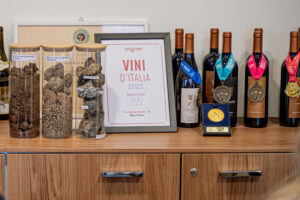Napa Valley Life Magazine, February 2024

The Castelli Romani, just south of metropolitan Rome, has a long, distinguished history. This grouping of hill towns in the Colli Albani (Alban Hills) is best known as the location of the Pope’s summer residence in Castel Gandolfo and as the setting for sought-after wine since the Roman Empire. Millennia of volcanic eruptions left their mark with crater lakes Nemi and Albano and mineral-rich volcanic soil throughout the region.
This is where ancient Roman nobility and popes sourced the most prized wine, and here, near the town of Velletri, the Ômina Romana (Roman Omens) winery and vineyards thrive. The vines—planted in volcanic soil, warmed by the Mediterranean sun, and cooled by sea breezes—grow in an optimal micro-climate that allows them to express their full potential. And it has—Ômina Romana used the fruit from these vines and state-of-the-art tools and scientific research to produce wine worthy of Italy’s highest rating: Tre Bicchieri.

When the 2023 Gambero Rosso Guide awarded the 2020 Ômina Romana Ars Magna Viognier with “Tre Bicchieri,” it marked a significant achievement for CEO Katharina Börner.
When her parents unexpectedly purchased the Lazio land and set out to start a winery, no one in the family had wine experience. Half-Italian and half-German, Katharina had grown up and trained as a CPA in Germany. She helped her parents with the finances, and her sister Maria-Teresa became an enologist. The planting began in 2007.
“For our first vintage, we made a micro-vinification of wines to understand the varieties and see what we could do. In 2013, we were ready to present the first vintage.”
That was when tragedy struck. “Just one week before we took the wine to market, my sister had a severe stroke,” Katharina explained, and her sister was no longer able to work with the winery. Katharina’s role expanded considerably while dealing with concern and care for her sister. “I was like,’ Oh my God, I have to look after my sister (they both live in Italy) and support my parents. I can’t let the winery fail.”
She got to work with her team, including Agronomist Paula Pacheco and Enologist Simone Sarnà. “I said, ‘I can’t make wine, but I can do the management and do sales.’” Speaking in her third language, English, Katharina hit the road. “I traveled a lot in the first years. I went to China and the US and all the shows like Gambero Rosso, wherever they were. I went to everything.”
Eventually, Katharina hired a salesperson. “She knocked on doors and said, ‘Look, I have a wonderful product—try this. And people would say, ‘Oh, you’re from Lazio. No, there’s no good wine there; we won’t even try this.’” But she would leave the wine. “They would taste it, call her, and say, ‘Please come back. I could not imagine that you could make this kind of wine.’”
The top scores followed. “The first great score that we got was 96 points from Decanter, and I was really, really proud,” Katharina gushed. Today, the wine continues to receive awards and acclaim. While rooted in Lazio, Ômina Romana is now distributed globally.


